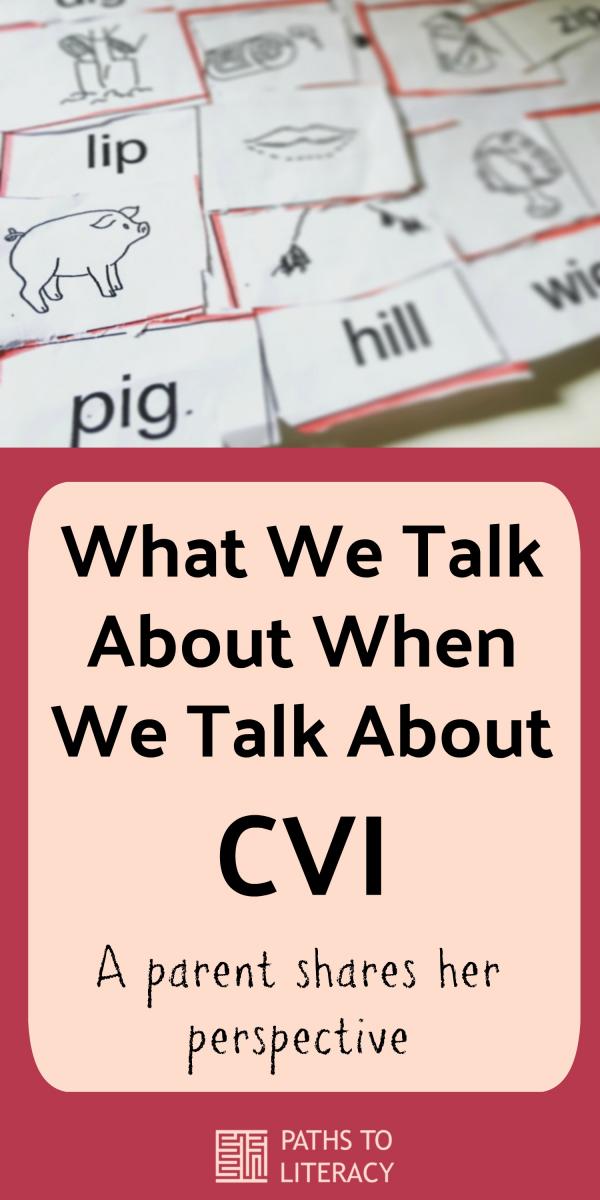What We Talk About When We Talk About CVI, Part One
 Novelty. Complexity of array. Sensory complexity. Preferred color. These are some of the characteristics of cortical visual impairment. More importantly, these are descriptors for my son’s vision. Such words have become a second language. At times it feels like a secret language. Learning any language is easiest when you are immersed in the culture. Our cultural immersion began with my son’s infant stroke and subsequent diagnosis of cortical visual impairment in 2011.
Novelty. Complexity of array. Sensory complexity. Preferred color. These are some of the characteristics of cortical visual impairment. More importantly, these are descriptors for my son’s vision. Such words have become a second language. At times it feels like a secret language. Learning any language is easiest when you are immersed in the culture. Our cultural immersion began with my son’s infant stroke and subsequent diagnosis of cortical visual impairment in 2011.
Educating My Son's Educational Team
When talking about Jasper, the words and language of CVI come easily. At this point, it is almost not possible to think about him without also thinking of complexity in all its forms, preferred color, field loss, distance viewing, to name a few. They are meaningful because they apply to my child, because these words define his vision, because without understanding these terms, it is hard to understand him. Educating my son’s educational team – which changes and rotates from year to year, starting from scratch each time – means providing reports on his most recent CVI Range assessment (Roman-Lantzy). It means creating original materials to help explain my son’s vision. It means providing his team links to appropriate online resources such as the CVI Teacher blog or the West Virginia Department of Education (yes, West Virginia).
Learning the Language of CVI
It all begins with learning the language. If you do not learn the language, reports and resources are meaningless. My son is only in kindergarten, but this started at birth, and I have educated many providers on his cortical visual impairment. Over and over, CVI is described as a “complex” diagnosis. Yet when sending updated reports or a particularly relevant blog post or website to his team, the messages are met with silence. No response, no questions from his educators. So how does this impact Jasper? How does this play out for him in the classroom? Like most CVI parents, I could talk about my son and CVI until blue in the face, but there are no questions. Every time, it makes me wonder how much they really understand about CVI.
At a recent CVI training with my son’s team, I put this to the test. (Ongoing CVI training is written into my son’s IEP under Staff Supports, and should be for every student who has CVI.) The meeting was called to address how to modify the mess of worksheets my son brings home from kindergarten, how to make the mess accessible to him, how to make learning accessible to him. Referring to my son’s list of IEP accommodations, I asked his team about close viewing. The tendency is to discourage young children from viewing anything too closely, like sitting too close to the TV. Why does Jasper need to be allowed to examine objects close up? Five teachers from his eight person team sat at the table, silent, looking at me. Surely everybody there was aware of Jasper’s accommodations, but they did not know the meaning behind the accommodations. When Jasper holds an object up close to view, he blocks out everything around it so that his brain can focus on that object. By doing this, his brain has less visual clutter to deal with, to process, so he can see that object. If the object is ten feet away, then his brain has to work harder to sort out all of that other surrounding visual information. He may not see that object ten feet away, not because it is blurry (acuity), but because his brain has to sort out that object from everything else that surrounds it. For the team it was an audible Aha moment.
As a parent, it was an alarming moment. How will educators ever understand our kids with CVI if they do not take the time to learn the language?
Visit Start Seeing CVI for more posts like this.


Comments
In response
re: Tracy
Brenda, your son is very
re: Christine